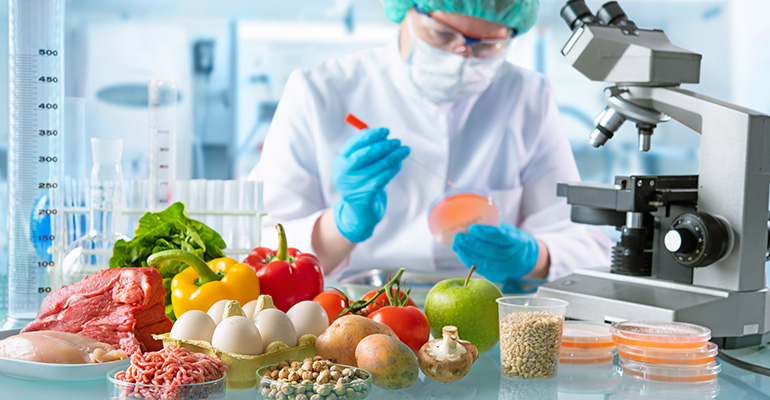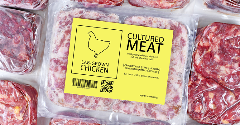News
Scientists use digital PCR technology to ensure food safety
18 Jun 2024Researchers are applying digital polymerase chain reaction (PCR) technology to accurately identify and quantify allergens in foods and adulteration in meat.
Food scientists use digital Polymerase Chain Reaction (dPCR) technology to confirm safety and authenticity. The technique is evolving traceability practices within the food sector to help manufacturers maximise safety and authenticity in the testing and inspection spaces.

“The high multiplexing capacity, sensitivity and possibility for absolute quantification allows a host of challenging questions to be answered concerning food safety and authenticity,” John Lillie, global food molecular development manager at SGS, a Swiss-headquartered testing, inspection and certification company, told Ingredients Network.
The emergence of digital PCR
Testing is crucial for ensuring compliance throughout food supply chains. With food items undergoing a heavy amount of processing, increasingly the industry is calling for DNA-based methods to determine safety and authenticity. DNA methods can detect elements within food items that may degrade and become untraceable.
Methods using real-time polymerase chain reaction (PCR) have been popular in the food sector due to their heightened sensitivity and subsequent effectiveness at detecting unwanted or harmful components. However, concerns over the technique’s accuracy due to food samples’ low yield, highly fragmented DNA, and high content of inhibitors have seen the technique emerge and evolve in its digital form.
The dPCR technique hailed as the third generation of PCR, was first described in the literature in 1999, and the first commercialised system came to the market in 2006. “dPCR has subsequently been refined, and the technique performed utilising a droplet approach and more recently micro and nanoplate,” Lillie said.
Focusing on food safety and authenticity, dPCR methods can address various concerns in food safety, such as genetically modified organism (GMO) screening, pathogen detection, and allergen detection, along with food authenticity, including meat detection.
Ensuring effectiveness in food safety and authenticity
In 2024, researchers analysed the use of dPCR for allergenic foods, signalling the first time the technique has been used to analyse allergenic foods in trace amounts. Researchers used a nanoplate dPCR method to trace allergenic foods. They found the method improved detection sensitivity and robustness to identify sesame in the food items analysed.
Researchers have analysed effective droplet dPCR methods for identifying and quantifying adulteration in raw and processed meat. The researchers developed a droplet dPCR platform designed to identify target species with high detection sensitivity. Using the method, they identified and quantified meat adulteration at low content levels. They stated that dPCR is an appropriate technique for government regulators and quality control departments responsible for monitoring commercial meat products and food businesses for routine analysis.
Digital over real-time monitoring
While both follow the same principles and reaction components, unlike quantitative PCR (qPCR), dPCR provides “easily implemented workflow without calibration curves”, said Lillie. The advantage of dPCR over qPCR has led to the digital technique gaining attention to confirm food safety and authenticity.
In dPCR, the PCR reaction is split into thousands of partitions and the DNA sample is randomly distributed. As a result, dPCR can be quantitative without the need for calibration curves, prompting a higher sensitivity and boosting resistance to inhibitors.
“These benefits, allied with the targeting of very short DNA fragments, make dPCR an excellent tool to deal with the high complexity of food and feed samples,” added Lillie. Food scientists with experience and expertise using DNA-based methods can improve their workflow by implementing dPCR instead of its real-time method.
The digital method also provides “robustness in the presence of inhibitors”, Lillie said. Food and feed matrices are often associated with a high level of processing as most ingredients undergo intense mechanical stress such as cutting and grinding, extremely high temperatures and/or ultra-freezing processes. “These procedures can seriously hinder the capacity of most methodologies to provide reliable results.”
However, due to their complex matrices, they are also typically rich in inhibitors. As a result, it can be hard to detect target DNA, particularly with technologies like real-time PCR (qPCR) that are susceptible to these substances and residues. “dPCR provides a precise and robust alternative to avoid the probability of false negative results originating from these issues.”
Quality control standards behind dPCR
“Although the methods are not regulated per se, development, validation and subsequent implementation in SGS labs follow specific and strict guidelines and standard operating procedures (SOPs),” Lillie added.
The non-governmental International Organization for Standardization (ISO) guides processes, procedures and best practices. In the absence of harmonised guidance, Food companies can follow these to achieve consistency and effectiveness and provide consumers with credible and trustworthy assurance.
For dPCR and qPCR best practices, businesses may follow ISO 20395:2019(E) specifically, focusing on biotechnology requirements for evaluating the performance of quantification methods for nucleic acid target sequences. Companies may also follow ISO 9001 and ISO/IEC 17025 as part of their operations, which include verification parameters such as reproducibility, repeatability and uncertainty measurements.
After the European Network of GMO Laboratories (ENGL) discussed using dPCR to analyse GMOs in 2014, a working group was established in 2015 to explore the technology. Then, in 2019, the EU Joint Research Centre published the ENGL working group final report, providing an overview and recommendations for the application of dPCR.
Related news

UK consumers could be eating cultivated meat within two years
26 Mar 2025
Cell-cultivated products (CCPs), from chicken nuggets to beefburgers, could be on UK supermarket shelves by 2027 after regulators launched a sandbox to accelerate approvals.
Read more
Protein diversification: A massive missed market?
20 Feb 2025
Germany and the UK could be missing out on the massive market for alternative meats and proteins, with one new coalition calling for an end to the “steak-tofu struggle”.
Read more
Most consumers lack trust in AI, but supplement users are ready to embrace the technology
14 Feb 2025
A survey of UK and US consumers found that most supplement users are willing to let AI make decisions on their behalf, but they also demand greater transparency.
Read more
Indians enjoy first bites of cultivated chicken
13 Feb 2025
The first public tasting of cultivated meat in India has taken place as the country prepares for the first commercial cultivated meat products – potentially as early as the end of this year.
Read more
UK publishes latest food security report
12 Feb 2025
The UK government releases its food security report 2024, detailing five core themes for bolstering and securing the future of the country’s food.
Read more
Leading regulatory updates in Asia in 2025
7 Feb 2025
As we head into 2025, numerous legislators around Asia are suggesting and solidifying legal updates and changes that will impact the food and beverage space.
Read more
Singapore introduces Food Safety and Security Bill
3 Feb 2025
Amid growing food safety concerns and supply chain disruptions, the Singapore Food Agency passes its Food Safety and Security Bill (FSSB) to provide greater clarity, assurance, and credibility.
Read more
Impossible Foods secures reinstatement of EU patent for heme protein
28 Jan 2025
The decision overturns the 2022 revocation of the patent and solidifies legal protection of the innovative ingredient that can be used in plant-based food production.
Read more
US wins GMO corn trade dispute with Mexico
24 Jan 2025
A Mexican decree banning imports of genetically modified (GM) corn for human consumption has been overturned in what has been hailed as a victory for US exports.
Read more
EU Parliament passes stricter packaging rules
20 Jan 2025
The European Parliament voted to approve updates to the packaging and packaging waste regulation, including enforceable re-use targets, limits on certain single-use packaging types, and restrictions on the use of PFAS “forever chemicals”.
Read more